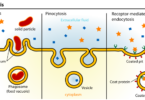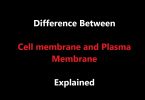Cementum vs Dentin
Summary: Difference Between Cementum and Dentin is that Cementum is comparable to bone in its proportion of inorganic to organic constituents and to similarities in its structure. The cementum is thinnest at its junction with the enamel and thickest at the apex. While dentin forms the bulk of the tooth. It consists of dentinal tubules, which contains the cytoplasmic process of the odontoblasts. The tubules are laid in the calcified matrix—the walls of the tubules are more calcified than the region between the tubules.

Cementum
The cementum is comparable to bone in its proportion of inorganic to organic constituents and to similarities in its structure. The cementum is thinnest at its junction with the enamel and thickest at the apex. The cementum gives attachment to the periodontal ligament fibers. Cementum forms throughout life, so as to keep the tooth in functional position. Cementum also forms as a repair tissue and in excessive amounts due to low grade irritants.
The cells that form the cementum; the cementoblast lines the cemental surface. Uncalcified cementum is usually seen, as the most superficial layer of cementum. The cells within the cementum, the cementocytes are enclosed in a lacuna and its process in the canaliculi, similar to that seen in bone, but in a far less complex network. Cementocytes presence is limited to certain regions.
The regions of cementum containing cells are called cellular cementum and the regions without it, are known as the acellular cementum. The acellular cementum is concerned with the function of anchorage to the teeth and the cellular cementum is concerned with adaptation, i.e. to keep the tooth in the functional position. Like dentin, cementum forms throughout life, and is also avascular and noninnervated.
Dentin
The dentin forms the bulk of the tooth. It consists of dentinal tubules, which contains the cytoplasmic process of the odontoblasts. The tubules are laid in the calcified matrix—the walls of the tubules are more calcified than the region between the tubules. The apatite crystals in the matrix are plate like and shorter, when compared to enamel. The number of tubules near the pulp are broader and closer and they usually have a sinusoidal course, with branches, all along and at their terminus at the dentinoenamel or cementodentinal junction.
The junction between enamel and dentin is scalloped to give mechanical retention to the enamel. Dentin is avascular. Nerves are present in the inner dentin only. Therefore, when dentin is exposed, by loss of enamel and stimulated, a pain-like sensation called sensitivity is experienced. The dentin forms throughout life without any stimulation or as a reaction to an irritant. The cells that form the dentin—the odontoblast lies in the pulp, near its border with dentin. Thus, dentin protects the pulp and the pulp nourishes the dentin. Though dentin and pulp are different tissues they function as one unit.
Also Read:
Difference Between Enamel and Dentin
Difference Between Enamel and Cementum
Difference Between Alveolar Bone and Cementum
Difference Between Cementum and Periodontal Ligament
Difference Between Cementum and Alveolar Bone







Leave a Comment
You must be logged in to post a comment.